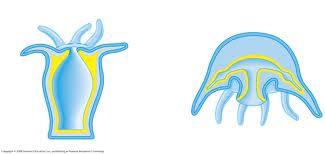Using this table as a reference, Which of the following are more...
Name the two stages of Phylum Cnidaria....
Choose One....
Skeletal System of Echinoderms is individual ossicles that allows for...
Class Crustacea are predominately marine, have 2 pairs of antennae,...
_________ is the top opening for sponges where water is...
Which of the following is the most advanced body cavity?
Reversible cell differentiation, found on phylum Porifera, is the...
Phyla Platyhelminthes remove waste and undergo gas exchange by...
Arthropoda are 90% of all known species who occupy every niche and...
The gastrovascular cavity in Cnidaria acts as a hydrostatic skeleton.
Class Myriapoda Subclasses:
Platyhelminthes and higher organism show Triploblastic tissue...
Morphology are ______ traits shared by separate species.
(Porifera) Sponges can alter the rate of movement the flagella beat,...
Arthropod SubPhyla Characteristics.
Four Sublclasses of Crustacea include: Malacostraca, Copepoda,...
Tunicates are the most closely related organism to vertebrates....
Coordinates movements and sensory structures on Cnidaria..
In Ophisthokonts, nucleariids gave rise to animals and...
Free living Rhabditophora (Planarians) are aquatic predators and move...
Phylum Cnidaria has maintained a simple body plan with radial symmetry...
Which of the following are the classes of phylum Porifera?
Match the decription with the class. (Porifera)
In Deutorostome Development, mouth develops from the blastophore and...
What is the name for the larvae form of Echinodermata?
Phylum Echinodermata have ______ symmetry in adult and ______ symmetry...
Phylum Porifera Morphology and Characteristics. Check all that apply.
Segmentation is a primary advantage for which of the following...
Malacostraca Order Taxonomy....
What are the three classes in Phylum Chordata? Sperate answers by coma...
Radial symmetry in Platyhelminthes move actively while Bilateral...
Cnidaria Characteristics Include: (Check All that Apply)
Chordate Characteristics Matching.
What are the Shared traits of Chordata? Check all that Apply.
Two main Subphyla of Arthropoda. Separate answers with coma and space....
Convergent evolution is the process in which organisms resemble each...
Which of the following characteristics pertain to Echinodermata?
Phylum Annelida is composed of 15,000 species, are diploblastic...
Place the following with correct description.
Match the following Supergroups of Protist with their respective...
Lancelet larvae feed on plankton in water columns by traping throuh...
Order the following from MOST ADAPTED to LEAST ADAPTED?
Match the Body Cavity type to the Phyla.
Platyhelminthes Classes include:
Which of the following are characterisitcs of "worms"?
Match the three structural grades in Porifera with their respect...
Evidence of first Photosynthetic Organism. Check all that Apply.
...
Development Matching.
Arthropod Matching
Which of the following are evidence of Evolution?
Match and describe the following Mechanism of Diversification of...
Place the following in chronoligal order from oldest to...
Cestoda Characteristics:
Match the following Classes and orders with their corresponding...
Porifera Characteristics. Check all that apply.
Characteristics of FIRST eukaryotes.
Match the following classes of Cnidaria with their respective...
Which of the following are characteristics of Protists?
What types of Symmetry are found in Platyhelminthes? (Check All that...
Match the characteristics with their respective protist organism.
Crustacea Subclasses:
Cuticle Characteristics.
Brain Nervous System in Arthropods Matching. What are the Controls...
Which of the following are Evolutionary Adaptations of Porifera?
Platyhelminthes Characteristics Include: (Check all that Apply)
















